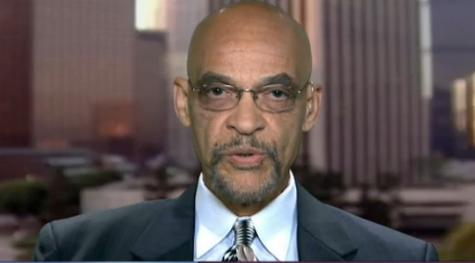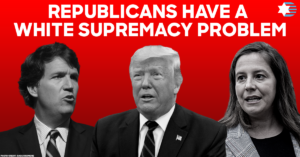Earl Ofari Hutchinson
This is the second of a two-part series on the GOP and racism. It’s an excerpt from his latest book Why the GOP Became a White Supremacist Party (Middle Passage Press)
Former President Donald Trump knew exactly what he was doing and didn’t even bother to hide it with his tweet in July 2019. He baited four Democratic congresswomen with taunts to go back to where they came from. This played hard on the antipathy of many Trump backers to the abhorrence of those of foreign-born ancestry. He then gleefully watched House Democrats pass a resolution branding his taunt as raw, naked, unabashed racism.
The response Trump wanted and got from his opponents paid instant dividends for him. He used it to rev up crowds into delirium at a rally in North Carolina that month. His approval rating nudged up. Polls showed that nearly all Republicans didn’t see anything racist about him or his bashes. But even more worrisome was that a lot of others who didn’t wear the GOP tag also didn’t think he was a racist.
None of this was new. It was tiring old stuff. But it worked. When he race-baited Black reporters in 2017 polls showed then that the great majority of
Trump supporters didn’t think there was anything wrong with using the N-word. Nor did they think anyone using the offensive term was a racist.
Nearly all saw nothing racist about the N-word and said they had no problem voting for someone who used the offensive epithet.
Most Democrats were appalled by this crude outburst of bigotry. However, this was less important than its underlying political implications. A lot of people simply didn’t have any problem with crude, harmful bigotry.
The oft-stated political article of faith was that Trump won in the key swing states in 2016 with his quasi-populist bringing back the jobs, industry, and American products to the U.S. pitch. But surveys of voter attitudes in those states that dug deeper found that this was more window dressing than anything else. Trump touched a raw, festering, nerve of racial animus that always lurked beneath the surface with many white voters in those states.
A July 2021 study Activating Animus: The Uniquely Social Roots of Trump Support,” published in the American Political Science Review underscored the potency of racial animus toward Blacks, minorities, and non-white immigrants. It was a potent force in garnering Trump millions of votes.
“So it’s not necessarily that it’s the Republican Party that is creating animus towards people, it’s that there’s this faction of Americans who dislike marginalized groups, noted Lilliana Mason John Hopkins University Political Science professor and one of the study’s authors, “And they’re attracted to one party or the other based on sort of the decisions of that party, and they’re able to kind of hide within the party to make American politics be focused more on the party and not on this faction of people who are feeling a lot of hatred towards marginalized outgroups.”
Tapping that animus was the staple in the GOP playbook stretching back to the Nixon years. Trump just did it louder, cruder, and more in your face than any of the other GOP presidential contenders.
He quickly figured out something else. The more he took outrageous racial shots at Democrats, civil rights leaders, and Blacks in general, he could be sure of igniting a spate of name-calling by them of him as a racist.
The four freshly minted leftist non-white congresswomen were the perfect foil to exploit his calculated racial baiting. He banked on them lashing back at him, House Democrats rallying behind them, and the media playing the back-and-forth exchange between them for all it was worth.
The distraction had a life of its own. This was just the kind of life that served to keep his base energized and outraged that their hero was under constant and unfair attack from the alleged evil and vindictive Democrats.
After he laid that groundwork, it was an easy step for him to crow that he would use hard-edged race-tinged appeals and attacks whenever and wherever he pleased in the run-up to the 2020 campaign. The media, the public Democrats, and the GOP were by then conditioned to expect and be variously outraged and mesmerized by the sheer breadth and audacity of his race-baiting. It was almost a perverse win-win for his crass, ugly, and very dangerous ploy.
This was in some ways reminiscent of how he conned enough newsrooms, talk show hosts, and legions of the GOP’s inveterate Obama bashers to talk up a Trump presidential candidacy in 2012 with the Birther issue and Obama. Trump got what he wanted then. Tons of fresh media attention, a momentary seat at the GOP presidential candidate’s chat table, and starry-eyed idolization from legions of ultra-conservatives and untold numbers of unreconstructed bigots.
The stakes were much higher for Trump after the multiple state and federal indictments. However, the game plan remained unchanged. That was to pour on the inflammatory rhetoric even hotter and heavier. The only certainty in all this was that race and now political victimization baiting could be stitched together again into a neat, serviceable, and well-recognized package that millions of Trump’s backers would buy into. Multiple polls taken after each of his indictments showed millions did.
Earl Ofari Hutchinson is an author and political analyst. His latest book is Why the GOP Became a White Supremacist Party (Middle Passage Press). He is the host of the weekly Hutchinson Report on KPFK 90.7 FM Los Angeles and the Pacifica Network. He is the publisher of thehutchinsonreport.net
Visit Hutchinsonlegacybooks.com

